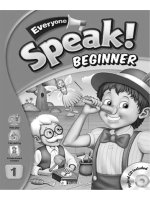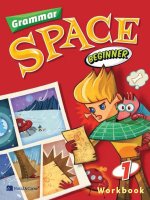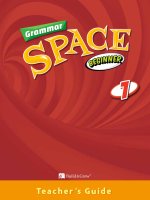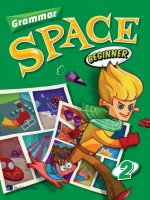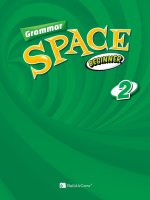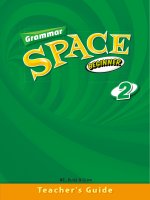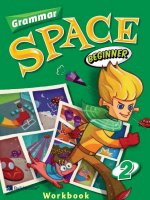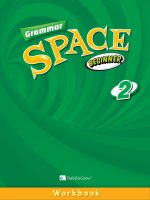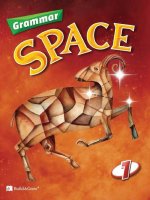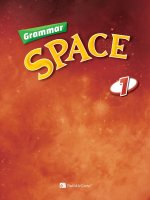Grammar space beginner 1 TG
Bạn đang xem bản rút gọn của tài liệu. Xem và tải ngay bản đầy đủ của tài liệu tại đây (18.76 MB, 78 trang )
r
a
m
ram
G
i n n er
g
e
B
1
Te a c h e r ’s G u i d e
Grammar Space Beginner 1
Contents
2
Grammar Space Beginner 1 Teacher’s Guide
3
Unit 1 |
Harry is my dog.
Grammar Station
1. Use the chart and pictures to help you explain what nouns are to the students. Write
on the board that a noun is a person, place, animal, or thing (ex. “student,” “school,”
“cat,” “pencil,” etc.), and have the students point out nouns in the classroom. Then
explain that there are two types of nouns. Common nouns are just normal nouns.
However, proper nouns are the names of specific nouns (ex. “Joe,” “Madrid,” “New
Year’s,” etc.) and must always have a capital (big) letter. Write on the board that
Objectives
1. The students will learn about common nouns and proper nouns.
2. The students will complete exercises to familiarize themselves with the key grammar
point.
3. The students will identify and correct simple mistakes related to the key grammar
point.
4. The students will apply their new grammar knowledge in a practical writing exercise.
5. The students will review the grammar point before the end of class to aid retention.
people, city, country, animal, days of the week, month, and holiday names are all proper
nouns with capital letters. Leave these explanations on the board throughout the class
for easy reference.
2. Give the students as many simple examples as necessary for them to understand
the grammar point. Make sure to write these on the board using different colors, if
possible, to highlight the different parts of the sentences. You can ask the students to
give you example topics to make this portion of the lesson more interactive.
3. Extra Idea (optional):
Give the students one minute to draw a picture of any noun they want. When they are
finished, collect all the pictures and pass them back out to the students at random.
LESSON GUIDE
Introduction
1. Ask a student to read the title out loud for the class, and then write it on the board to
use as an example later.
Then write “people,” “places,” “animals,” and “things” on the board and tell the
students to tape their pictures under the right category and write the correct words
beside them.
4. When you feel that the students have a good grasp of the grammar point, draw their
attention to the exercise below. Tell them to stand up. Slowly read through all the
words in the exercise, and have the students jump or clap and say, “Noun!” any time
2. Scan the unit before class and identify any words that your students may not
understand. Then at the start of class, post pictures or write simple definitions of the
they hear a noun. Once you’ve finished saying them all, have the students circle them
in their books.
words on the side of the board for the students to refer back to throughout the class.
4
Grammar Space Beginner 1 Teacher’s Guide
5
Check Up
As you work through the check up and practice exercises, walk around the classroom
Practice
1. For exercise A, have the class read the sentences all together, but call on students at
and encourage the students to ask you questions if they ever get confused. Also, make
random to tell you what the nouns in each sentence are. Once you have gone through
sure to check each exercise and explain any common errors so that the students can
all the sentences, say each noun and have the students yell, “Common!” or “Proper!”
correct their answers and learn from their mistakes.
and write it in the appropriate column.
1. For exercise A, ask several students to describe what they see in the pictures. Then
2. For exercise B, ask several students to describe the pictures for you, including who is
go back through and have the students match the pictures to the nouns and types of
in them, what they are doing, and where they are. Then have the students fill in the
nouns. If you like, put the exercise structure on the board and ask a student to match
sentences on their own, and ask the different sides of the class to take turns reading
it for you.
the sentences out loud.
2. For exercise B, go through a few of the nouns in the box as a class and put them into
3. For exercise C, put the students into pairs. Have them work together to identify what is
the correct categories. Once the students understand how to do the exercise, have
wrong in each underlined phrase and rewrite the sentences. As the students start to
them finish it on their own. Call the fastest four students to list the people, animals,
finish the exercise, call on some of them to write the sentences on the board for you.
places, and things on the board for you, and check them as a class.
3. For exercise C, tell the students that they need to choose whether to have a big
or small letter in the option. Then call on different students to read through the
sentences, but have the whole class use their hands to show “big” or “small” when
the students reach the options at the end of the sentences.
4. Extra Idea (optional):
Split the students into two or three teams. Have each team send a person to the
board and say a simple noun for them to write as fast as they can. However, tell them
that if you say a proper noun, they should include a big letter when they write it. Give
the fastest student to correctly write the noun a point for their team and have the
teams switch writers. Continue until all the students have participated once or twice.
Grammar in Writing
1. Emphasize to the students that this writing exercise ties the grammar they have
learned into practical writing for the future. Start the exercise by asking general
questions about the writing type. Some possible ideas are:
a. Why do people write emails?
b. Do you have your own email account?
c. Who do you email the most?
2. Ask several students to describe what they see in the pictures. Then have the
students fill in the blanks on their own from the words in the box. When everyone is
finished, have the students read through the exercise out loud all together or in turns.
6
Grammar Space Beginner 1 Teacher’s Guide
7
3.Extra Idea (optional):
ANSWER KEY: STUDENT
WORKBOOK
BOOK
Have the students write their own emails about three or four sentences long like the
one in the previous exercise on extra pieces of paper. Encourage them to use both
common nouns and proper nouns, and if necessary give them the structure, “Dear
_____, My name is ______. I am a ______. My dad is a ______. His name is ______.
My mom is a _____. Her name is ______. I hope to see you soon! From, ______.” Edit
these emails and have the students take turns presenting them at the front of the
class when everyone is finished.
Review and Workbook
1.Tell the students to complete the chart at the bottom of the page as fast as they can
as a review. They shouldn’t have any problems with it by this point. While they do that,
put the chart’s structure on the board. Have the students fill it in for you as they start
finishing up.
2.Before class, print enough unit review tests for all the students from www.
nebuildandgrow.com (For Teachers → Test Sheets → Grammar → Grammar Space
Beginner 1). When everyone is finished with the review chart, have all the students
take the tests on their own. If possible, have them check their answers with a partner
or go through the tests all together before the end of class. If the students struggled
with any of the test questions, review the material some more.
3.The corresponding workbook unit is intended as homework so the students can review
what they have learned at home. However, you can also go through the workbook in
class if you would like to be present for additional grammar practice with the students.
8
Grammar Space Beginner 1 Teacher’s Guide
9
ANSWER KEY: WORKBOOK
Unit 2 |
This is a dress.
Objectives
1. The students will learn about the articles a, an, and the.
2. The students will complete exercises to familiarize themselves with the key grammar
point.
3. The students will identify and correct simple mistakes related to the key grammar
point.
4. The students will apply their new grammar knowledge in a practical writing exercise.
5. The students will review the grammar point before the end of class to aid retention.
LESSON GUIDE
Introduction
1. Review the previous unit (common and proper nouns) before starting your lesson.
Show each student a flashcard with a common noun and a proper noun on it (ex. “boy”/
“ben”) and ask them which word should start with a big letter.
2. Ask a student to read the title out loud for the class, and then write it on the board to
use as an example later.
3. Scan the unit before class and identify any words that your students may not
understand. Then at the start of class, post pictures or write simple definitions of the
10
Grammar Space Beginner 1 Teacher’s Guide
11
words on the side of the board for the students to refer back to throughout the class.
Check Up
As you work through the checkup and practice exercises, walk around the classroom
and encourage the students to ask you questions if they ever get confused. Also,
make sure to always check each exercise and explain any common errors so that the
students can correct their answers and learn from their mistakes.
Grammar Station
1. Use the chart and pictures to help you explain what articles are to the students. Write
1. For exercise A, continue using flashcards of the nouns or say them like you did in the
previous exercise. If you like, you can speed up the rate you go through the cards or
on the board that the articles a, an, and the go in front of nouns (ex. “a pen,” “an
even expand into common items around the classroom. Then have the students write
elf,” “the cat,” etc.), and that a and an go before singular nouns (with an going before
down the nouns and articles.
vowels). Then have them point out objects in the classroom and say them with the
proper articles in front. Explain that the goes in front of unique nouns or specific nouns
2. For exercise B, give the students 15-20 seconds to complete the sentences while
that have already been defined (ex. “the sky,” “the cat [that was already mentioned]”).
making it obvious that you are timing them. Once the students are finished, have the
Leave these explanations on the board throughout the class for easy reference.
two sides of the classroom alternate reading the sentences out loud.
2. Give the students as many simple examples as necessary for them to understand
3. For exercise C, ask a few students to describe the pictures. Remind the students
the grammar point. Make sure to write these on the board using different colors, if
that the first time they refer to something, they should use a or an, but after that
possible, to highlight the different parts of the sentences. You can ask the students to
they should use the. Then slowly read through the sentences, but pause at the word
give you example topics to make this portion of the lesson more interactive.
options so that the students can yell out which article best completes them. Call on
individual students to read the sentences out loud when you are finished.
3. Extra Idea (optional):
Have all the students come to the board and write two or three nouns on it anywhere
they choose. Then have them make a line, and give the first student a wadded-up
paper ball. Tell them to throw it at the board and say whichever noun it lands closest
to with either a or an in front of it. Then have the next student take a turn, and so on.
To make it harder, tell the students that if they land on a noun that has already been
said, they have to say the in front of it instead.
Practice
1. For exercise A, ask the class to yell out what they see in the picture. Then have them
4. When you feel that the students have a good grasp of the grammar point, draw their
attention to the exercise below. Hold up flashcards of the nouns in the exercise and/or
say them. For each one, have the students respond with “a!” or “an!” as appropriate.
say only what they see on the girl’s table, followed by only what is on the boy’s table.
Tell the students to complete the sentences describing the pictures when they have
identified everything on both tables, and have the whole class read them out loud.
Then have them circle the words in the exercise.
12
Grammar Space Beginner 1 Teacher’s Guide
13
2. Extra Idea (optional):
Have all the students stand up and rotate three chairs to the right. Then put them into
is finished, have the students read through the story out loud all together or in turns.
If you like, have different students read the story in different emotions.
pairs and have them describe the objects on the desk that they just arrived at to their
partners using the sentence structure from the previous exercise (i.e. “ [name] has
_____, _____, _____, and _____.” Repeat as often as you like.
3. Extra Idea (optional):
Have the students write their own stories about three or four sentences long like the
one in the previous exercise. Tell them that the topic is “going to a birthday party,”
3. For exercise B, ask a student to read through the example. Then read through the first
and encourage them to use articles to talk about the things that they see there. If
sentence of the first problem, omitting the article. Ask the student if we know which
necessary, give them this structure to work with: “My friend _____ has a birthday party
elephant, and when they say “no” tell them that means they should use an. Then
today! There is ___ _____, ___ _____, ___ ____, and ___ ____. ___ _____ tastes very
do the same with the second sentence, but when they respond “yes” tell them that
good. I gave my friend ___ _____ as a present. ___ _____ is very interesting.” Edit
means they should use the. Continue like this through the rest of the problems or have
these stories and have the students take turns presenting them at the front of the
the students finish them on their own. Then have the boys and girls alternate reading
class when everyone is finished.
the sentences out loud.
4. For exercise C, put the students into pairs. Have them work together to identify what is
wrong in each underlined phrase and rewrite the sentences. As the students start to
finish the exercise, call on some of them to write the sentences on the board for you.
Review and Workbook
1. Tell the students to complete the chart at the bottom of the page as fast as they can
as a review. They shouldn’t have any problems with it by this point. While they do that,
put the chart’s structure on the board. Have the students fill it in for you as they start
Grammar in Writing
1. Emphasize to the students that this writing exercise ties the grammar they have
finishing up.
2. Before class, print enough unit review tests for all the students from www.
learned into practical writing for the future. Start the exercise by asking general
nebuildandgrow.com (For Teachers → Test Sheets → Grammar → Grammar Space
questions about the writing type. Some possible ideas are:
Beginner 1). When everyone is finished with the review chart, have all the students
a. Do you like stories? Why or why not?
take the tests on their own. If possible, have them check their answers with a partner
b. What is your favorite story?
or go through the tests all together before the end of class. If the students struggled
c. Who usually tells you stories?
with any of the test questions, review the material some more.
2. Ask several students to describe what they see in the picture. Then have the students
fill in the blanks on their own using the articles that they have learned. When everyone
14
Grammar Space Beginner 1 Teacher’s Guide
15
3.The corresponding workbook unit is intended as homework so the students can review
ANSWER KEY: STUDENT BOOK
what they have learned at home. However, you can also go through the workbook in
class if you would like to be present for additional grammar practice with the students.
16
Grammar Space Beginner 1 Teacher’s Guide
17
ANSWER KEY: WORKBOOK
Unit 3 |
He has three watches.
Objectives
1. The students will learn about singular nouns and plural nouns.
2. The students will complete exercises to familiarize themselves with the key grammar
point.
3. The students will identify and correct simple mistakes related to the key grammar
point.
4. The students will apply their new grammar knowledge in a practical writing exercise.
5. The students will review the grammar point before the end of class to aid retention.
LESSON GUIDE
Introduction
1. Review the previous unit (articles) before starting your lesson. Show each student a
flashcard with a picture on it and have them say, “There is a/an _____.”
2. Ask a student to read the title out loud for the class, and then write it on the board to
use as an example later.
3. Scan the unit before class and identify any words that your students may not
understand. Then at the start of class, post pictures or write simple definitions of the
words on the side of the board for the students to refer back to throughout the class.
18
Grammar Space Beginner 1 Teacher’s Guide
19
Grammar Station
1. Use the chart and pictures to help you explain what singular nouns and plural nouns
Check Up
As you work through the check up and practice exercises, walk around the classroom
are to the students. Write on the board that singular nouns are for one person, place,
and encourage the students to ask you questions if they ever get confused. Also, make
animal, or thing, while plural nouns are for more than one person, place, animal, or
sure to check each exercise and explain any common errors so that the students can
thing (ex. “cat” vs. “cats”). Then go over the spelling rules for plural nouns (most
correct their answers and learn from their mistakes.
nouns: add –s; nouns ending in –ch, -sh, -s, -x, or –o: add –es; nouns ending in a
consonant and –y: delete the –y and add –ies; nouns ending in –f(e): delete the –f(e)
1. For exercise A, say each noun in the box and ask the students to tell you what its
and add –ves). Leave these explanations on the board throughout the class for easy
plural form is. Then tell them to divide the nouns into the right boxes based on their
reference.
spellings. Ask the first four students who finish to write the nouns on the board for you
under the correct categories.
2. Give the students as many simple examples as necessary for them to understand
the grammar point. Make sure to write these on the board using different colors, if
2. For exercise B, ask several students to describe what noun is in each picture as
possible, to highlight the different parts of the sentences. You can ask the students to
well as how many of the noun there are. Then read through the phrases, but let the
give you example topics to make this portion of the lesson more interactive.
students all say the plural nouns together while they write them in. Finish the exercise
by pointing at the different pictures randomly and having the students say the phrases
3. Extra Idea (optional):
that go with them.
Bring as many students to the board as you can fit. Give them each a marker and
tell them to write out the plural noun that you say as fast as possible. Then give the
3. For exercise C, give the students 15 seconds to choose which plural noun spelling
student who correctly writes the noun the fastest a point, and bring up new students.
is correct in all of the problems. Then read through the sentences, but make the
Continue as long as you like, but make sure to use a variety of nouns with different
students yell out the answer for each one and spell it out loud. Either have the class
spelling rules.
read the sentences all together or call on different students to read them out loud
when you’re finished.
4. When you feel that the students have a good grasp of the grammar point, draw their
attention to the exercise below. Tell them to check all the correct plural nouns on their
own. Then have them hold up the right number of fingers and say the numbers of the
problems that they checked. Last, have all the students read the phrases out loud and
correct the ones that were wrong.
Practice
1. For exercise A, ask several students to describe what they see in the picture in as
much detail as possible. Then go through the nouns in the box above and have the
students say their plural forms after you say their singular forms. When you are
finished, have the students complete the exercise on their own and read through it all
20
Grammar Space Beginner 1 Teacher’s Guide
21
together.
2. Ask several students to describe what they see in the pictures. Then read through the
information about the garage sale and have the students fill in the blanks on their own
2. Extra Idea (optional):
Tell the students that you are going to have an objects competition. Explain that they
based on the pictures. When everyone is finished, point at the pictures randomly and
have the students say the phrases that go with them.
need to find as many of the same item as they can anywhere in the classroom, bring
them to their desks, and sit down within the space of 30 seconds. For example, one
3. Extra Idea (optional):
student may find 12 pencils, another may find 15 books, and another may find 8
Have the students write their own garage sale advertisements like the previous
jackets. Go around the room and have each student say, “I have ___ _____.” The one
exercise. Tell them to take a blank sheet of paper, write “Garage Sale!” at the top,
with the most objects is the winner. Make sure all the objects are returned to their
and make up “When” and “Where” details to write under the title. Then give them two
original owners after the game is done.
minutes to draw five or six pictures of items with prices to sell at their garage sales,
but say that these objects all have to be plural. When they are finished, tell them to
3. For exercise B, go through the example on the board to show the students how to
write, “There are ___ _____,” under each picture to practice the unit’s grammar. Edit
change the starting sentences into plurals. Then ask four volunteers to come to the
these advertisements and have the students take turns presenting them at the front
board and write out the sentences that you give them as fast as possible. Check the
of the class when everyone is finished.
sentences as a class when they are done.
4. For exercise C, put the students into pairs. Have them work together to identify what is
wrong in each underlined phrase and rewrite the sentences. As the students start to
finish the exercise, call on some of them to write the sentences on the board for you.
Review and Workbook
1. Tell the students to complete the chart at the bottom of the page as fast as they can
as a review. They shouldn’t have any problems with it by this point. While they do that,
put the chart’s structure on the board. Have the students fill it in for you as they start
Grammar in Writing
1. Emphasize to the students that this writing exercise ties the grammar they have
22
finishing up.
2. Before class, print enough unit review tests for all the students from www.
learned into practical writing for the future. Start the exercise by asking general
nebuildandgrow.com (For Teachers → Test Sheets → Grammar → Grammar Space
questions about the writing type. Some possible ideas are:
Beginner 1). When everyone is finished with the review chart, have all the students
a. What is an advertisement?
take the tests on their own. If possible, have them check their answers with a partner
b. What advertisements do you see a lot?
or go through the tests all together before the end of class. If the students struggled
c. Do you like seeing advertisements? Why or why not?
with any of the test questions, review the material some more.
Grammar Space Beginner 1 Teacher’s Guide
23
3.The corresponding workbook unit is intended as homework so the students can review
ANSWER KEY: STUDENT BOOK
what they have learned at home. However, you can also go through the workbook in
class if you would like to be present for additional grammar practice with the students.
24
Grammar Space Beginner 1 Teacher’s Guide
25
ANSWER KEY: WORKBOOK
Unit 4 |
He wants some water.
Objectives
1. The students will learn about count nouns, noncount nouns, and some.
2. The students will complete exercises to familiarize themselves with the key grammar
point.
3. The students will identify and correct simple mistakes related to the key grammar
point.
4. The students will apply their new grammar knowledge in a practical writing exercise.
5. The students will review the grammar point before the end of class to aid retention.
LESSON GUIDE
Introduction
1. Review the previous unit (singular and plural nouns) before starting your lesson. Show
each student a flashcard with a common singular noun on it (ex. “baby”) and ask them
to spell its plural out loud.
2. Ask a student to read the title out loud for the class, and then write it on the board to
use as an example later.
3. Scan the unit before class and identify any words that your students may not
understand. Then at the start of class, post pictures or write simple definitions of the
26
Grammar Space Beginner 1 Teacher’s Guide
27
words on the side of the board for the students to refer back to throughout the class.
Corner.” Say each noun from the exercise and tell them that they should run to the
correct side of the room. Then have the students say the plurals for the nouns in
the Count Corner and “some _____” for nouns in the Noncount Corner. When you
are finished, have them run back to their seats and circle the count nouns and draw
triangles around the noncount nouns afterward.
Grammar Station
1. Use the chart and pictures to help you explain what count nouns and noncount nouns
are to the students. Write on the board that count nouns are nouns we can count that
have singular and plural forms (ex. “student,” “desk,” “chair,” etc.), while noncount
nouns are nouns we can’t count that only have singular forms (ex. “water,” “milk,” “air,”
Check Up
etc.). Go over the common noncount nouns with the students and explain that liquids
As you work through the check up and practice exercises, walk around the classroom
and abstract ideas that they can’t see (ex. “information,” “music,” etc.) are noncount
and encourage the students to ask you questions if they ever get confused. Also, make
nouns. Then explain that we usually use some in front of noncount nouns instead of
sure to check each exercise and explain any common errors so that the students can
a or an, and that some can also go in front of count nouns to mean a few or several.
correct their answers and learn from their mistakes.
Leave these explanations on the board throughout the class for easy reference.
1. For exercise A, tell the students that they need to put a or an in front of the count
2. Give the students as many simple examples as necessary for them to understand
the grammar point. Make sure to write these on the board using different colors, if
nouns and X in front of the noncount nouns. Then have them go through the exercise
as fast as they can and read all the phrases together (without saying the X’s).
possible, to highlight the different parts of the sentences. You can ask the students to
give you example topics to make this portion of the lesson more interactive.
2. For exercise B, ask a few students to describe the pictures. Then go through each
problem and have the students yell out together which word goes in front of the noun
3. Extra Idea (optional):
while they circle it.
Write a bunch of nouns all over the board and have the students line up and take turns
throwing a wadded-up paper ball at it. For whichever noun the ball lands closest to,
3. For exercise C, give the students thirty seconds to read through the sentences and
have the entire class say “Count!” or “Noncount!” all together. A little bit of repetition
circle the correct phrases to complete them. Then call on different students to read
is all right, but if possible try to use nouns that are different from the ones in the next
the sentences on their own. Another option is to have all the students stand up and
exercise.
read them together as dramatically as possible.
4. When you feel that the students have a good grasp of the grammar point, draw their
attention to the exercise below. Have them all stand in a group, and designate one
side of the room as the “Count Corner” and the opposite side as the “Noncount
28
Grammar Space Beginner 1 Teacher’s Guide
29
Practice
1. For exercise A, have a few students describe the picture. Then say the nouns in the
box at the top and have the students say “Count!” or “Noncount!” after each of them.
When the students are ready, have them fill in the list, but remind them that only the
count nouns should be plural. Call on several students to come write the words on the
c. Is it better for stories to have a happy or sad ending? Why?
2. Ask several students to describe what they see in the picture, and ask them questions
about it. Then have the students fill in the blanks on their own from the words in the
box. When everyone is finished, have the students read through the exercise out loud
all together or in turns.
board for you when they are finished.
3. Extra Idea (optional):
2. Extra Idea (optional):
Give the students one or two minutes to draw pictures of things that their parents buy
at the grocery store. When the time is up, have each of them show their pictures to
the class and say, “My mom/dad needs _____.” Encourage them to be as creative as
they want in the things their parents buy.
Have the students write their own stories about three or four sentences long like
the one in the previous exercise on extra pieces of paper. Encourage them to use
both count nouns and noncount nouns, and tell them that their stories should be
about finding a house full of food like Hansel and Gretel. If necessary, give them this
structure to work with: “I am in a house full of food. There are ___ _____, ___ _____,
and ___ _____. I also see some _____ and _____. I like to eat/drink the _____ the
3. For exercise B, ask the students whether count nouns or noncount nouns need
articles, and then tell them they have 20 seconds to fill in the sentences with either
most.” Edit these stories and have the students take turns presenting them at the
front of the class when everyone is finished.
a, an, or X. When the time is up, have the two sides of the room alternate reading the
sentences out loud in a competition to see which side is louder.
4. For exercise C, put the students into pairs. Have them work together to identify what is
wrong in each underlined phrase and rewrite the sentences. As the students start to
finish the exercise, call on some of them to write the sentences on the board for you.
Review and Workbook
1. Tell the students to complete the chart at the bottom of the page as fast as they can
as a review. They shouldn’t have any problems with it by this point. While they do that,
put the chart’s structure on the board. Have the students fill it in for you as they start
finishing up.
Grammar in Writing
1. Emphasize to the students that this writing exercise ties the grammar they have
learned into practical writing for the future. Start the exercise by asking general
questions about the writing type. Some possible ideas are:
a. Do you like fairytales? Why or why not?
2. Before class, print enough unit review tests for all the students from www.
nebuildandgrow.com (For Teachers → Test Sheets → Grammar → Grammar Space
Beginner 1). When everyone is finished with the review chart, have all the students
take the tests on their own. If possible, have them check their answers with a partner
or go through the tests all together before the end of class. If the students struggled
b. Do you know the story of Hansel and Gretel?
30
Grammar Space Beginner 1 Teacher’s Guide
31
with any of the test questions, review the material some more.
ANSWER KEY: STUDENT BOOK
3.The corresponding workbook unit is intended as homework so the students can review
what they have learned at home. However, you can also go through the workbook in
class if you would like to be present for additional grammar practice with the students.
32
Grammar Space Beginner 1 Teacher’s Guide
33
ANSWER KEY: WORKBOOK
Unit 5 |
He is Bob.
Objectives
1. The students will learn about subject pronouns and the verb be.
2. The students will complete exercises to familiarize themselves with the key grammar
point.
3. The students will identify and correct simple mistakes related to the key grammar
point.
4. The students will apply their new grammar knowledge in a practical writing exercise.
5. The students will review the grammar point before the end of class to aid retention.
ANSWER KEY: Review Test 1
LESSON GUIDE
Introduction
1. Review the previous unit (count and noncount nouns) before starting your lesson.
Show each student a flashcard with a noun on it (ex. “girl,” “milk,” etc.) and have them
say, “There is a/some _____.” Make sure the flashcards are split between count and
noncount nouns.
2. Ask a student to read the title out loud for the class, and then write it on the board to
use as an example later.
3. Scan the unit before class and identify any words that your students may not
34
Grammar Space Beginner 1 Teacher’s Guide
35
understand. Then at the start of class, post pictures or write simple definitions of the
4. When you feel that the students have a good grasp of the grammar point, draw their
words on the side of the board for the students to refer back to throughout the class.
attention to the exercise below. Tell the students to match the subjects with the
correct forms of the verb be. Then say each subject pronoun in a random order and
have the students respond with the correct form.
Grammar Station
1. Use the chart and pictures to help you explain what subject pronouns are to the
students. Write on the board that subject pronouns are short words that replace nouns
Check Up
(ex. “I,” “you,” “he,” “she,” etc.). Point out that it and they are used for animals and
As you work through the check up and practice exercises, walk around the classroom
things. Have the students point at different people (including themselves) around the
and encourage the students to ask you questions if they ever get confused. Also, make
classroom and use the pronouns to describe them. Then go through the verb be and
sure to check each exercise and explain any common errors so that the students can
how it changes depending on the subject (i.e. “I am,” “You/We/They are,” “He/She/It
correct their answers and learn from their mistakes.
is”). Last, go over how to shorten subject pronouns and the verb be into contractions
(ex. “You’re,” “She’s,” “It’s,” etc.). Leave these explanations on the board throughout
the class for easy reference.
1. For exercise A, read each subject out loud and have the students all say its subject
pronoun together as they write it. Then have the boys and girls take turns reading the
sentences out loud.
2. Give the students as many simple examples as necessary for them to understand
the grammar point. Make sure to write these on the board using different colors, if
2. For exercise B, have a few students describe what they see in the pictures. Then
possible, to highlight the different parts of the sentences. You can ask the students to
have the students go through the exercise and complete the sentences on their own
give you example topics to make this portion of the lesson more interactive.
with the verb be. When they are finished, call on various students to read through the
sentences out loud.
3. Extra Idea (optional):
Bring a pinwheel with all the subject pronouns written on it to class with you. Have the
3. For exercise C, have the students look at the example and remind them that subject
students come to the front all at once and take turns spinning the pinwheel, running
pronouns and be can be shortened into contractions. Then ask for volunteers to come
back to their desks, and writing their subject pronouns, the correct forms of be, and
to the board and write the contractions for the problems that you give them while the
the appropriate names of people in the class (including their own, if applicable). For
other students work on them in their books. Check the contractions on the board all
example, if a student spun “We” they might run back and write, “We are Tom and
together before moving on.
Jessica.” Repeat as often as you want and have the students read their sentences out
loud when everyone is finished.
36
Grammar Space Beginner 1 Teacher’s Guide
37
Practice
1. For exercise A, give the students 30-45 seconds to write the subject pronouns for the
sentences as fast as they can. Then have the two sides of the class compete to see
2. Ask several students to describe what they see in the pictures, and then ask them
questions about The Wizard of Oz. Have the students fill in the blanks on their own
using the correct forms of the verb be, and when everyone is finished have the
students read through the exercise out loud all together or in turns.
how loud/quiet they can read the sentences.
3. Extra Idea (optional):
2. Extra Idea (optional):
Make a bunch of simple sentences for the students before class and scramble them
up. Give each student one or two sentences to unscramble and have them read them
out loud and/or write them on the board.
Have the students write their own book reports about Harry Potter (or another book
they are familiar with). Encourage them to write at least three or four sentences
like the previous exercise while using the verb be and subject pronouns correctly. If
necessary, give them this structure to work with: “Harry Potter ___ a wizard. _____
and _____ ___ his best friends. They ___ at Hogwarts. It ___ a school for magic. Harry
3. For exercise B, ask several students to describe the pictures for you, including who
is in them, what they are doing, and where they are. Then go through the sentences
as a class and call on different students to read the first sentence, but have all the
___ very brave. ___ ___ a hero for many people.” Edit these book reports and have
the students take turns presenting them at the front of the class when everyone is
finished.
students read the second sentences together.
4. For exercise C, put the students into pairs. Have them work together to identify what is
wrong in each underlined phrase and rewrite the sentences. As the students start to
finish the exercise, call on some of them to write the sentences on the board for you.
Review and Workbook
1. Tell the students to complete the chart at the bottom of the page as fast as they can
as a review. They shouldn’t have any problems with it by this point. While they do that,
put the chart’s structure on the board. Have the students fill it in for you as they start
Grammar in Writing
1. Emphasize to the students that this writing exercise ties the grammar they have
learned into practical writing for the future. Start the exercise by asking general
questions about the writing type. Some possible ideas are:
a. What is a book report?
b. What books have you written reports on?
c. What is your favorite book? Why?
38
finishing up.
2. Before class, print enough unit review tests for all the students from www.
nebuildandgrow.com (For Teachers → Test Sheets → Grammar → Grammar Space
Beginner 1). When everyone is finished with the review chart, have all the students
take the tests on their own. If possible, have them check their answers with a partner
or go through the tests all together before the end of class. If the students struggled
with any of the test questions, review the material some more.
Grammar Space Beginner 1 Teacher’s Guide
39
3.The corresponding workbook unit is intended as homework so the students can review
ANSWER KEY: STUDENT BOOK
what they have learned at home. However, you can also go through the workbook in
class if you would like to be present for additional grammar practice with the students.
40
Grammar Space Beginner 1 Teacher’s Guide
41
ANSWER KEY: WORKBOOK
Unit 6 |
I’m not a teacher.
Objectives
1. The students will learn how to use the verb be in negative sentences and yes/no
questions.
2. The students will complete exercises to familiarize themselves with the key grammar
point.
3. The students will identify and correct simple mistakes related to the key grammar
point.
4. The students will apply their new grammar knowledge in a practical writing exercise.
5. The students will review the grammar point before the end of class to aid retention.
LESSON GUIDE
Introduction
1. Review the previous unit (subject pronouns and the verb be) before starting your
lesson. Bring a pinwheel with all the subject pronouns on it to class. Have each
student spin the wheel and make a simple sentence using the pronoun they spun, the
correct form of be, and the appropriate name of someone in the class. For example, if
a student spun “They” they could say, “They are Sally and Joe.”
2. Ask a student to read the title out loud for the class, and then write it on the board to
use as an example later.
42
Grammar Space Beginner 1 Teacher’s Guide
43
3. Scan the unit before class and identify any words that your students may not
exercise out loud randomly and tell the students to jump or clap and say “Correct!” if
understand. Then at the start of class, post pictures or write simple definitions of the
there are no mistakes in them. You can expand to other sentences as well. Then have
words on the side of the board for the students to refer back to throughout the class.
the students check the correct ones in their books.
Grammar Station
1. Use the chart and pictures to help you explain to the students how to use the verb be
Check Up
As you work through the check up and practice exercises, walk around the classroom
in negative sentences and yes/no questions. Write on the board that they just need to
and encourage the students to ask you questions if they ever get confused. Also, make
put not after the verb be to make sentences negative (ex. “I am not sad.”), and that
sure to check each exercise and explain any common errors so that the students can
is not and are not can be shortened to isn’t and aren’t. If you like, have the students
correct their answers and learn from their mistakes.
stand and take turns making simple negative sentences. Then explain that to make
yes/no questions, they just need to put the verb be before the subject (ex. “Am I a
1. For exercise A, go through the sentences all together. Call on different students to
student?”), while to make answers they should put the verb be after the subject (ex.
read through the first sentences, and after each one say the subject of the next
“Yes, you are.” “No, you aren’t.”). Leave these explanations on the board throughout
sentence and let the students fill in the blanks for you. If you like, have the girls and
the class for easy reference.
boys alternate reading the sentences out loud when they are finished filling them in.
2. Give the students as many simple examples as necessary for them to understand
2. For exercise B, use the example to demonstrate how to change the starting sentence
the grammar point. Make sure to write these on the board using different colors, if
into a question. Then ask five students to come to the board and compete to see who
possible, to highlight the different parts of the sentences. You can ask the students to
can change the sentence you give them the fastest. If you like, you can make up more
give you example topics to make this portion of the lesson more interactive.
sentences for other students to change at the board so that they have a chance to
participate too.
3. Extra Idea (optional):
Have all the students write down three different be questions on slips of paper and
3. For exercise C, ask several students to describe the picture for you in as much
put them into a bag or hat. Then have them make a line, draw out the questions,
detail as possible. Then put the students into pairs and have them work together
read them out loud, and answer them in full sentences. If any of the questions have
to complete the answers to the questions. When they are finished, have the pairs
mistakes in them, have the students that picked them identify and fix them.
practice the questions and answers together.
4. When you feel that the students have a good grasp of the grammar point, draw their
attention to the exercise below. Tell them to stand up. Say the sentences in the
44
Grammar Space Beginner 1 Teacher’s Guide
45
4. Extra Idea (optional):
Give the students one or two minutes to draw a picture of anything they want. Then
have all the students stand up, leave their drawings, and move three chairs to the
left. Underneath their new drawings, have them write three questions about them.
Then have them move three more chairs to the left. Underneath those drawings and
questions, tell the students to answer the questions that the previous student wrote.
Also, if they see any mistakes in the questions, tell them to fix them. Put the students
into pairs and have them practice the questions and answers when they are done.
Grammar in Writing
1. Emphasize to the students that this writing exercise ties the grammar they have
learned into practical writing for the future. Start the exercise by asking general
questions about the writing type. Some possible ideas are:
a. What is an interview?
b. Have you interviewed someone before? Who?
c. What kind of things can you ask someone in an interview?
2. Ask several students to describe what they see in the picture. Then have the students
fill in the blanks on their own with the correct subjects and forms of be. When
everyone is finished, have the students read through the exercise out loud in pairs.
Practice
1. For exercise A, have the class read each starting sentence all together once. Then
3. Extra Idea (optional):
Have the students choose partners to interview. Encourage them to each write three
or four questions to ask that person, and then switch papers so their partners can
have them read the same sentence, but tell them to yell out “not!” each time the verb
write their answers down. If necessary, give them these question structures to work
be appears. Then remind them how to make contractions out of be + not and have
with: “____ ____ ____ years old? ____ your mom/dad a _____? ____ _____ your friend?
them finish the exercise on their own. If you like, have them read through the new
____ ____ in ____ grade?” Edit these interviews and have the students take turns
sentences all together.
presenting them at the front of the class when everyone is finished.
2. For exercise B, ask several students to describe the pictures for you, including who
or what is in them, what they are doing, and where they are. Then use the first Q&A
pair as an example to show the students how to figure out which subject to use in
the question based on the answer. Have the students pick partners out of a hat and
practice the sentences together.
3. For exercise C, put the students into pairs. Have them work together to identify what is
wrong in each underlined phrase and rewrite the sentences. As the students start to
finish the exercise, call on some of them to write the sentences on the board for you.
Review and Workbook
1. Tell the students to complete the chart at the bottom of the page as fast as they can
as a review. They shouldn’t have any problems with it by this point. While they do that,
put the chart’s structure on the board. Have the students fill it in for you as they start
finishing up.
2. Before class, print enough unit review tests for all the students from www.
nebuildandgrow.com (For Teachers → Test Sheets → Grammar → Grammar Space
46
Grammar Space Beginner 1 Teacher’s Guide
47
Beginner 1). When everyone is finished with the review chart, have all the students
ANSWER KEY: STUDENT BOOK
take the tests on their own. If possible, have them check their answers with a partner
or go through the tests all together before the end of class. If the students struggled
with any of the test questions, review the material some more.
3.The corresponding workbook unit is intended as homework so the students can review
what they have learned at home. However, you can also go through the workbook in
class if you would like to be present for additional grammar practice with the students.
48
Grammar Space Beginner 1 Teacher’s Guide
49
